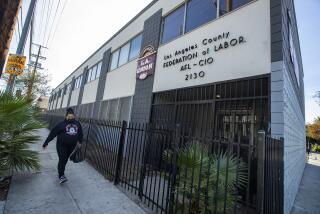From L.A., It’s ‘City Council Live’ : TV Cameras at Rehearsal Don’t Seem to Change Flow of Things
- Share via
Some predicted that gavel-to-gavel TV coverage of Los Angeles City Council meetings would increase the length, if not the level, of debate.
Others said live cablecasts would force council members to spiff up their wardrobes, or, at the very least, show up on time.
But Day 1 of “City Council Live” arrived Wednesday morning, and the cast, as usual, drifted in almost 30 minutes late. Nary a power tie was in evidence. And the only council member to even mention the debut of the cameras during floor debate was the always-effusive Nate Holden.
“That’s normal Nate,” Council President John Ferraro noted. “Vintage Nate.”
It was business as usual at City Hall, except for one thing.
“The best free theater in Los Angeles,” Councilman Joel Wachs said, “is going to a larger audience.”
Similar in scope and intent to the now-familiar C-SPAN coverage of Congress, “Council Vision” is designed to bring local government into the living rooms of the 500,000 cable subscribers in the city. Beginning next month, the thrice-weekly sessions, which are unlikely to ever rival Oprah, Phil or Geraldo in the ratings, will be aired live on a new local government station, Channel 35. For those with something else to do during the day, the meetings will be re-broadcast at 6 p.m.
This month, the council is engaged in what is in essence a dress rehearsal of its new show. Wednesday’s initial telecast was available in only about 100 offices at City Hall as the city Department of Telecommunications irons out technical kinks in its $670,000 broadcasting system.
The cablecasts, employing six remote-controlled cameras unobtrusively perched on walls and ceilings of the City Council chambers, present a somewhat sanitized picture of the proceedings. At the order of wary council members, the cameras will be trained only on whoever is speaking.
“The policy means the camera won’t be focused on councilmen asleep at their desks, picking their noses or reading their mail,” explained Councilman Michael Woo, with a smile. “It will probably mean not that much change in the actual conduct on the floor.”
Councilwoman Joan Milke Flores, a long-time proponent of “Council Vision,” defended the system against the specter of censorship at a preview press conference Wednesday morning.
Declaring that the cameras would remain on the speakers even if there is a riot in the audience, Flores said the broadcasts are designed for “citizens to learn more about what their government is doing--not the reaction.”
“Council Vision” officially came into being at 10:27 a.m. when a frustrated Ferraro was finally able to cajole a quorum’s worth of council members to take their seats.
The cameras, controlled by an unseen four-member crew, proceeded to follow the sometimes-Byzantine debate on items ranging from quitclaims of easements to police foot patrols.
During the debate on police patrols, a citizen activist made the first televised impassioned appeal for action.
Sobbing loudly, Beverly Christiansen, a Koreatown resident, said, “I hope all of you that are watching on television, that if we don’t get foot patrols, that we will come out en masse.”
Afterward, Christiansen explained she was not mugging for the cameras. She had also cried in a previous address before the council, she said.
More to Read
Sign up for Essential California
The most important California stories and recommendations in your inbox every morning.
You may occasionally receive promotional content from the Los Angeles Times.













